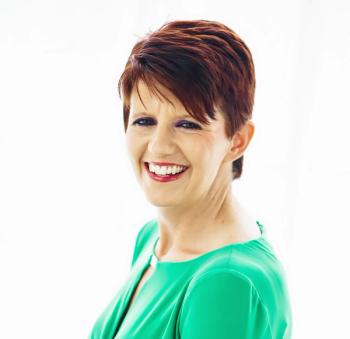
Can you find happiness where you are?
That's the million-dollar question. Here's how your colleagues who were tempted to quit found ways to ease the pressures.
Your Career Guide
Can you find happiness where you are?
That's the million-dollar question. Here's how your colleagues who were tempted to quit found ways to ease the pressures.
By Anne L. Finger
Senior Editor
"Things wouldn't be so bad with my practice if it weren't for ________." You fill in the blank: The phone calls? The pressure to see too many patients? The paperwork hassles? The constant battles with insurance companies? The absence of a life outside the office?
Let's assume you're not so burned out that nothing short of escape to a fabled desert isle will comfort you. And you're not so depressed that you're immobilized and really need treatment. Though dissatisfied, you're determined to stay put and improve a less-than-perfect practice situation. But what can you do? And where should you begin?
Practice management consultant Socrates said it best: "Know thyself." You gain the greatest satisfaction when you're working toward your goals in accordance with your personal values.
If helping others is a core value, then consider teaching at a nearby medical school or volunteering at a clinic for the uninsured. Do you want to expand your practice and become better known in your community? Join the local Lions Club, or volunteer to give free health promotion and disease prevention lectures at the high school, church, or senior center, suggests Thomas A. Ludwig, director of the University of Wisconsin Health-East Clinic in Madison. "You'll feel a real sense of accomplishment, and elderly people will become some of your most loyal patients," he says.
If you're like most physicians, your wish list for achieving satisfaction probably focuses on two related issuesgaining greater control of your practice and greater balance between your work and your family life. To achieve this balance, write yourself a prescription: Set aside time to exercise, garden, return to the guitar, take up the fluteanything that will restore your sense of well-being. At that point, you'll be able to think more clearly and figure out the changes you must make. And don't stint on sleep. When you're running on empty, you become irritable, and little things bother you more than they should.
Well-rested, with a clear head and an understanding of your own priorities, you'll be able to consider the changeslarge and smallthat can make your life more rewarding.
Bring in reinforcementstemporarily or permanently
An ophthalmologist in rural Michigan has had difficulty finding someone to cover his practice so he can take vacations, reports practice management consultant Michael LaPenna of Grand Rapids. Recently he's turned to locum tenens physicians, who give him an opportunity to recharge his batteries.
Family practitioners John and Judith Egerton, who have a busy practice in Friendswood, TX, turned to a locum tenens when they were approaching burnout a few years ago. That worked so well that they ended up bringing in one associate, then another. "We've reduced our workweek to three days, although we often work a fourth. But now that our weekends are sometimes longer than our workweek, we feel we've made it," John says. And the extra hands have brought in extra patients, so there's been no loss of income.
Another way the Egertons have simplified their lives is by signing over their inpatients to hospitalists. "That's made the biggest difference," says John. "And we haven't had any complaints from patients." Initially, many doctors view hospitalists with suspicion, says LaPenna. "But over time, doctors realize that although it's a different style of care, it can be excellent. And it certainly changes the lifestyle of physicians who use it."
Has call got you down? Solo pediatrician Andrea J. Leeds of Bellmore, NY, has signed up with an after-hours triage service provided by the local children's hospital. "My patients love it!" she says. "At first, I thought they'd abuse the opportunity, but letting them know that I pay for the service has encouraged their discretion."
Call had become unmanageable for nephrologist Bayard Paul Quinn of Texarkana, TX, when a fourth associate joined his practice. "To make the call days less awful, I've simply stopped seeing afternoon office patients when I'm on call," Quinn says. According to Quinn, this approach reduces productivity somewhat, but it's much less stressful. "I can be anywhere, but I can't be two places at once," he explains.
A trio of physicians overwhelmed by being on call every third night adopted an uncommon approach: They agreed to share call with 12 other physicianstheir competitors. "They still compete in their office environment," reports LaPenna, "but on nights and weekends, this expanded call group has improved everyone's lifestyle."
Make sure others have clear expectations
If patients' demands seem unreasonable, perhaps it's because they don't know what to expect of you. Compose clear practice guidelines, and either post or distribute them to your patients, recommends family practitioner and physician coach Ahnna Lake of Stowe, VT.
Pediatrician Andrea Leeds goes through such an exercise with her patients' parents even before they join her practice. In a complimentary consultation, she says, "I explain how I run my practice: I'm available seven days a week by appointments only, and Friday, Saturday, and Sunday are just for sick visits. I do not have evening hours. Parents can reach me by phone during my daily calling hour, but I will not interrupt caring for patients to take their phone calls at other times. Finally, I assure them I will treat their child as I would my own." Leeds knows that if the parents don't like what she says, she won't hear from them again. And if she isn't comfortable with them, she doesn't "invite" them into her practice. This screening works very well, she says. "Overall, I believe that I have the nicest group of patients around."
Your staff needs clear expectations, too. "With trained personnel, you can handle more work, because they can pick up much more of the load," says Robin Ryan, a career coach and author in Seattle. Cardiologist David F. Schaefer of Rochester Hills, MI, learned that lesson serendipitously. About two years ago, he began to dread going to the office, but he didn't know why. When his secretary had to quit for family reasons, his wife, an RN who'd been doing his treadmill tests, announced she was taking over the front desk.
"I was hesitant," he says. "As kind and competent as she is, she'd never had a desk job and knew nothing about diagnosis codes, intensity-of-service codes, copays, and deductibles." He also worried that his wife's position might lead to conflicts with other employees. But despite his qualmsand the warning of a physician friend that the new job would endanger their marriagehe acquiesced.
"The office has never run better," he says. Collections more than doubled within five weeks. The other two employees have suddenly realized that they must take more initiative. "Most important, I'm glad to go to the office, because I no longer feel overwhelmedI don't have to complete tasks that others didn't do," he says. "The greatest part is that my wife and I get along better now than we have in yearsdue in part to her realization that she's a valuable asset to the practice."
Approach scheduling and administrative hassles with flexibility
Just because you've been accustomed to a certain schedule doesn't mean it must stay that way. A Colorado physician found himself hating his work every afternoon. His solution? Stop scheduling appointments after 11:30 am. Take two hours off for a jog, a shower, and lunch. Come back refreshed, ready to resume the day.
Sometimes the answer is to start earlieror later. "Some of my clients are starting office hours at 7:30 am and walking out the door by 5:30 pm," says Ryan. "That defuses tension from a spouse who says, 'Your child is always asleep by the time you get home.' "
Alternately, solo FP Debbie N. Heck of Muncie, IN, says, "I'm not a morning person. I start office hours at 9 am three days a week, and at 10 on the other two." Heck sees patients during lunch hour (she and her staff grab a bite on the run) so that they can finish by 3 or 4 pm. "I value my health, family, and sanity," she says of her 30- to 35-hour week. "I don't make as much money as I could, but I also don't want to be a burned-out doctor who isn't useful to my patients."
Most doctors tend to avoid administrative work, but that's sometimes a mistake, says internist Mark Linzer, a researcher with the Physician Work Life Study at the University of Wisconsin in Madison. Linzer has been studying how stress can be modified by achieving greater control over work. "By giving administrative issues to someone else, you lose control over things you know about," he says. "You know better how to move patients through your office: how to triage your work, and how to decide what can be handled by your RN, medical assistant, or receptionist. There may be ways to split up your workload that allow you to see more patients and spend more time with them. But that requires restructuring your workplace."
In John Egerton's approach to reducing hassles, he did away with his office lab. "It took up precious space, yet we performed only minor testsCBCs, rapid strep screens, urinalysesand sent out the rest," he says. The modest income was hardly missed, and the costly CLIA regulations and stressful federal inspections weren't missed at all. Plus, the space was quickly occupied by a new associate.
Don't be afraid to tackle the big problems, either. Not enough time with your patients? "Long-term relationships with patients remain the leading source of job satisfaction, and should be protected at all costs," says Mark Linzer. But most doctors say they need 20 to 30 percent more time with patients. Linzer's liberating response: Just give yourself more time. "There will be consequencesmore patients in the waiting room and less income. But almost without question, there will be more satisfaction."
John Egerton says: "I've abandoned the mad rush to see six patients an hour, and now see four. "The slower pace has made all the difference."
If you're despairing over the general state of medicine, working directly on the issues helps, says Ahnna Lake. "When you do something effective, the feeling of stress diminishes," she notes. "I'm involved in my state medical society. Sometimes I'm tired at night, and I don't feel I can afford the time, but I force myself to go to meetings. I'm revitalized when I'm there."
Dare we say it? Consider scaling back
Much of the stress of today's practice comes from struggling against declining reimbursements. "Trying to make as much money as you did before managed care translates into mountains of paperwork and too many patients crammed into a day. And your reimbursements end up reduced still further," says Robin Ryan.
Her solution: "Cut your entire overheadat work and home. Nothing will make life easier for you than living below your means."
Though it may sound facile to suggest you can be happier living on less money, some of your colleagues have found that to be true. One of Ryan's physician clients in Boston reported feeling that she was "drowning" in huge mortgage payments. She and her husband bought a less expensive house, trimming their mortgage payments from $4,500 a month to just $800. "Avoid the trap of bigger, bigger, bigger, which leads to more stress," Ryan emphasizes.
FP Bernd A. Wollschlaeger of North Miami Beach, FL, says he's done that. "I have ceased to participate in managed care," he reports. "I shape my practice to my needs instead of letting my practice get to me." Wollschlaeger says he now finds the time he's long sought to write and lecture (about nutritional and herbal medicine and medical information technology), to teach medical students, and to integrate computers into his practice. "I earn less," he acknowledges. "But I have gained job satisfaction."
Jeffrey C. Schultz, an FP from Baltimore, has learned to live on less, too. Schultz went through a period of practice breakup, divorce, and major medical problems simultaneously. "Among the positive outcomes of this experience was that I learned I didn't need a big income to be happy," he says. Schultz works a four-day week, does volunteer work, and goes rock climbing in the afternoons when he wants to. "Some days I pick up my daughter from school and do a special activity with her," he says. "And I think I'm more sympathetic and sweeter with patients than I used to be.
"I used to think of retiring early," Schultz says. "But I gave up a large fraction of my retirement plan in the divorce, so that seems less likely now. On the other hand, I no longer feel so compelled to get out of medicine."
My cure for burnout: Job sharing
By John A. Vanek, MD
Radiologist/Oberlin, OH
When I looked in the mirror and saw burnout, I knew I had to do something. The quality of my life had become more important to me than my finances. I wanted time to pursue other interests and take better care of my health.
But scaling back to part time was not practical. As a senior, full partner in our group, I would get caught in the trap of working nearly full time for part-time pay, or leaving the office at the pre-set time and being perceived as less than committed to the practice. And I couldn't discount the wisdom of those who say that a physician's job may be too important to leave to a part-timer. But does a full-time position need to be filled by only one person?
After some negotiation, my group permitted me to share one position with a junior partner. She had three young children and liked the idea of having more time with her family. Our basic skills and training were similar, making us essentially interchangeable.
Our group required that the arrangement be "cost neutral," so that our shared full-time equivalent position would cost the practice no more financially than any other full-time slot. We would each receive half of the usual fringe benefits. Where it was necessary to duplicate costs, such as for health insurance, pension and profit-sharing contributions, and malpractice insurance, our group's business manager would prepare a yearly, itemized list of expenses. Then the manager would equalize any discrepancies by reducing our year-end wages or bonuses.
My partner and I chose to work one full day per week each, either Monday or Friday, giving us both three days off whenever our full-time equivalent position was scheduled to have the weekend free. We each worked half-days on Tuesdays through Thursdays. We alternated working weekends and taking night call, doubling the number of weekends off for each of us, and cutting in half the number of on-call nights.
If one of us required more time off because of short-term illness or personal needs, the other would work and be repaid at a later date. Thus, our single position was essentially free of absenteeism. In fact, our combined productivity increased to the point where we were among the top producers in the group.
For me, the benefits were instantaneous: I felt refreshed and less stressed. After years of personal neglect, I found time to exercise again and watch my diet. I enjoyed having more time for myself and my family, and more energy for my work. Medicine began to be fun again.
My job-sharing arrangement lasted for eight years, until I recently retired. (I've embarked on a second career as a writer.) Because of our success, the group has made job-sharing positions available to other partners. Each team structures its arrangement a little differently.
Could you accept living on half of your current salary, with some reduction in benefits? I look at it this way: Several more years of fulfilling medical practice at half -salary is better than being crushed by the weight of modern medicine, a stress-induced myocardial infarction, or early retirement caused by job dissatisfaction.
Innovative group practices may find that accommodating creative employment options brings increased productivity, long-term retention of valued members, and a gentler transition when a partner retires.
Coming to terms: One solo doctor's candid story
By Mike Christian, DO
Family Physician/Moses Lake, WA
Five years ago, not only did I want to be anywhere but Moses Lake, WA, but I was frankly suicidal. Desperate to find any job, anywhere, I was willing to leave my familywho didn't want to moveor to commute long distances. One way or another, I had to escape.
In this county of 55,000, all medical needs are met by three practices: the satellite of a large multispecialty group, a hospital-owned family practice group, and methe only solo family doc. With the onset of managed care, the atmosphere had become competitivealmost cutthroat. Although I could compete successfully for business, I was frozen out of vital areas such as call coverage. Being available 24/7, I became exhausted, angry, and frustrated. I've since realized that bad things happen to good people all the time, and the measure of who you are is how you respond. I responded poorly.
I alienated just about everyone I knew. When even minor conflicts occurred, I escalated to the most antagonistic level possible. I had a list of people I simply ignoredeven when I met them face to face. I drove away my two excellent employees, who had been with me for years. And I was verbally brutal with my wife.
When I received a job offer, I told my wife that if I didn't take it, I couldn't go on. She said she'd go wherever I wanted, but only if I'd get help.
I saw a therapist and took antidepressants. The meds got me better sleep, and that helped. The therapist didn't. I couldn't resolve being on call all the time, but he didn't seem to understand how draining that was.
I turned down the job offer because I realized that moving wouldn't change anything; I'd be taking much of my baggage with me. Then one of the hospital doctors called and asked if I'd be interested in a coverage arrangement. I'm not sure why that stroke of luck occurred, but perhaps it was because of my changed demeanor.
For the next six months, I made amends by asking forgiveness of everyone I'd offended. That was hard: Some of them were people I didn't like or respect, and I still don't. Others were people I'd driven away, and I really missed themthey're now among my closest friends.
I'm no longer isolated. I can get coverage whenever I need or want it. I have a nice practice with a great staff. And my wife and I are celebrating our 25th anniversary with a trip to Hawaii.
If I hadn't taken responsibility for my own attitudes and behavior, I know nothing would have changed.
Making more by working less
By Jonathan S. Levy, MD
Family Practitioner/Eugene, OR
At age 53, after 26 years in practice, I was ready for a change. Don't get me wrongI still enjoyed medicine. The hassles of dealing with managed care, paperwork, and the occasional drug-seeking patient were only mild annoyances. But in many ways, medicine had become too easy. I found myself repeating the same words almost by rote, as if they were lines in a play. Clearly, I needed new challenges.
Although I could afford to retire, I decided to experiment with a practice-sharing arrangement instead. I wanted to wake up in the morning and, depending on the weather and my whim, pursue my interests or just sit in the garden and read without worrying about my patients or the office. There were classes in archeology, geology, and creative writing I had always wanted to take, but had never been able to fit in.
After considerable discussion, one of my four partners, Pete, agreed to merge his full practice with mine. Essentially, we would act as one doctor for the combined practice, which would allow us to use one office, three exam rooms, and one office nurse.
To make this work, we started seeing patients an hour earlier and added another half-day per week. The overflow went to the new doctor we brought into the group. This increased my weekly patient volume by 25 percent. It also increased our earnings by 10 percent each, since volume was up but fixed expenses were halved.
We share equally in fixed expenses such as rent, utilities, maintenance, phones, housekeeping, equipment, and legal and accounting services. Each doctor is responsible for his own supplies, dictation, CME, dues, and insurance.
Half of the staff expense is shared equally. The other half is allocated according to each doctor's share of the clinic's total patient volume. Income and charges are doctor-specific. When we see another doctor's managed care patient, the treating physician is paid $50. This formula may not work in your practice, but it's done well for us.
The arrangement had other benefits, as well. Sharing the practice increased my energy and enthusiasm; I was much more efficient, knowing that I could work five days and have at least nine days to recover. I now take seven months off, yet I actually earn more than when I had 12 weeks of vacation.
At the one-year mark, the arrangement is working perfectly. Our other partners are happy because their overhead has decreased, and our new partner has almost a full practice.
When we began the arrangement, we worried about continuity of care, and whether patients would feel they were being shuffled back and forth. We've avoided that; very few patients have left our practice, and new ones have made up for those losses. To assure continuity, you need a partner who practices the same style of medicine as you, so that patients feel comfortable with both doctors. You also need to write clear chart notes and talk with each other so nothing falls between the cracks An added benefit: Having both physicians evaluate the patient helps, because one of us may pick up something the other missed.
Tip:
Anne Finger. Can you find happiness where you are?. Medical Economics 2001;1:88.
Newsletter
Stay informed and empowered with Medical Economics enewsletter, delivering expert insights, financial strategies, practice management tips and technology trends — tailored for today’s physicians.














